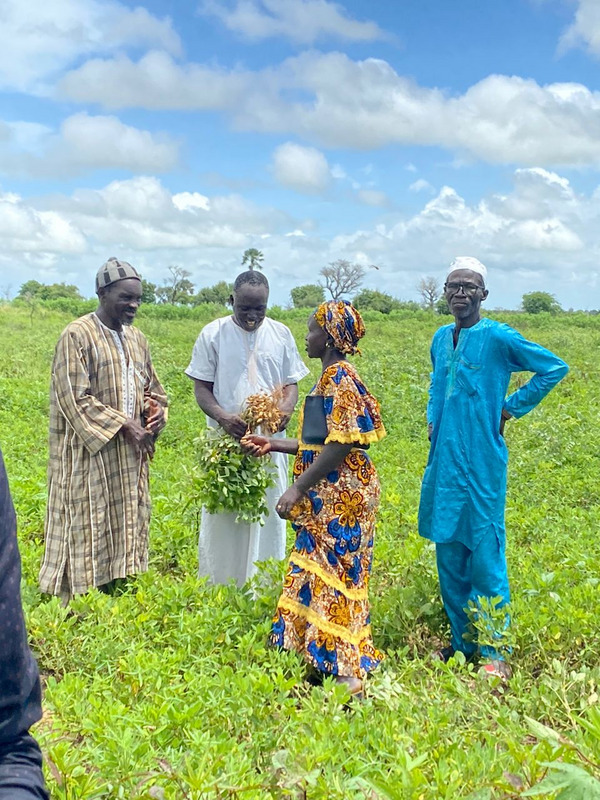The activities started in Dahra at the ISRA Senegalese Institute of Agricultural Research in order to present and evaluate the Acacia tortilis - Balanites aegyptiaca set-up, with 10 plants of each of these two species, established to monitor the primary production of herbaceous species that will grow under and outside the canopy. Some of the selected trees are fenced and the rest are left open to freely passing animals in order to compare the effect of the fence on the floristic composition of the grasses, their primary production and the soil characteristics. This visit was appreciated by the partners, who however note a low amount of biomass growing under the trees. In addition, there was an invasion of a grass called Diodia Scandens.
Then on to Ouarkhokh where the experiments, located in the community plot, are set up in long and short term fallows that have not been cultivated for more than 10 and 3 years respectively. In each area, five treatments are proposed.
A visit to the field enabled the producers to better explain the research work that is being carried out there. Some of them have started to replicate these trials and they are seeing positive returns, especially with the use of Guiera leaves as straw and organic matter.
Mulching
Mulching with Guiera is the leading technique, and is very popular with producers in Ouarkhokh and Niakhar, who see their crops becoming more and more profitable. Many of them have testified to its effectiveness, "I work with researchers, we took the leaves of the Guiera and scattered them on the ground, and I saw that my millet crops were much more profitable. I tried the same technique this year, you can see the difference with the naked eye compared to the other plots where I didn't put Guiera. I encourage farmers to stop burning the Guiera leaves and use them as mulch in their crops, it's better than fertiliser."
In Burkina Faso, particularly at Saria, several techniques have been developed, especially mulching with several types of woody biomass with associations to improve yields of Sorghum. As in the case of farmers, where producers combine the biomass they find, whereas in the field trials, researchers combine biomass while checking the value of each of them, "we want to be able to tell producers that if you use such and such type of biomass in such and such quantity, your soil and crops will improve. Here, producers are not used to composting biomass, they don't know their individual value. We have composting methods that they don't know about, we want to put in place technologies that are within the reach of all producers. It is important that they know how to select the woody plants around them according to their production objectives," says INERA researcher, Dr Barthelemy Yelemou.
Reforestation
SustainSahel is also a reforestation project, with seedlings donated to the communities of Ouarkhokh and Niakhar, Senegak. In total, 17 species of trees were made available. "These species were produced at the request of the population, because they realised that many species that were present in their farming system and that were very useful to them had disappeared over the years. So they wanted to have these species back in their locality. This was possible thanks to the SustainSahel project. We brought in species that had almost or completely disappeared from these localities, such as Véne, Detarium microcarpis, Adansonia Digitata, among others," explains Professor Bassirou Diallo, who is in charge of research at ISRA's plant production research laboratory.
Learning by video
Before the end of each meeting, micro SD cards were distributed to the producers. These cards contain 9 learning videos on integration, cultivation, shrubbery and livestock. They were produced by Access Agriculture and were downloaded in local languages: Wolof, Fulani, Serer and Moré - more information on these efforts in 'Farmer-to-farmer training videos translated into local languages' news.
Recommendations from the dissemination events
At the end of these dissemination days in Senegal and Burkina, the recommendations made were almost the same, among others:
- Involve young people more in the implementation of the project. Encourage them to cultivate and innovate.
- Encourage producers to reforest through assisted natural regeneration, but also follow up to see if the donated seedlings and seeds are being put to good use.
- Encourage producers, especially those in Ouarkhokh, to engage in production, as they have plenty of space.
- Work harder to mobilise producers, especially in Niakhar, because not many of them came to the dissemination days. They need to be mobilised to have more interest in the project.
- Producers need to do more to take the initiative in order to have a good harvest.
Written by: Ndeye Fatim Lô, Communication specialist at CSE.

 tap and then scroll down to the Add to Home Screen command.
tap and then scroll down to the Add to Home Screen command.